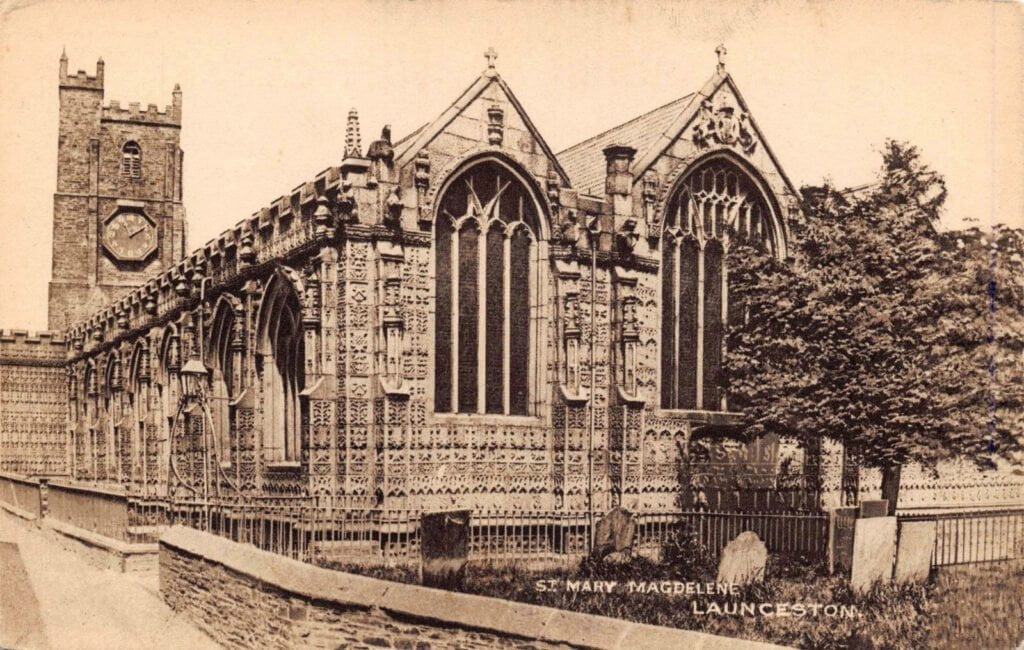Cornwall’s churches are a wonderful source of material for the local historian, and the Church of St. Mary Magdalene in Launceston is no exception. A family that was once prominent in the town is now remembered by its memorials in the Church. In the days before the National Health Service and the Trades Description Act, chemists and apothecaries often produced their own “cures”. In 1796 John Ching, a Launceston Chemist, patented a worm lozenge and made his fortune: opening a shop in London as well as Launceston. The family prospered over the years and built up their business by expanding into that of tea merchant and wine merchant. The Chings contributed greatly to the well being of the town and provided Launceston with its mayor on several occasions. There were, however, sad times as well as the good…. On the wall of the south aisle is a monument to Thomas Procter Ching, aged 22, youngest son of Alderman Thomas Ching of the town of Launceston. It reads: In the month of August 1834, having been wrecked in the Ship ‘Charles Eaton’ on a voyage to China, (he) suffered a more cruel fate at the hands of ignorant savages, by whom the crew was decoyed and murdered on the island of Boydang in the Torres Straits. Although it is not stated on the tablet, it has long been a Launceston folklore story that the unfortunate young Ching’s cruel fate was to have been eaten by cannibals. The late Canon W. G. Steer, Vicar of St. Mary Magdalene, confirmed this story, adding the information that the boy had been educated at Eton, and that he believed that when the memorial was put up it was suggested that it should bear the words: “From Eton to Eaton and Eaten”. Perhaps this was a cruel joke of the time, but now it is impossible to establish. The Charles Eaton was a barque and was on voyage from Sydney to Singapore when on August 31st, 1834, she was wrecked on the Great Barrier Reef near the Sir Charles Hardy Islands. Five men in a boat did get away and reached Amboina and Batavia. The natives murdered the remaining 27 people on board, with the exception of two boys – John Ireland and William D’Oyley, the ship’s boy and a passenger’s child, aged two. It appears from the account of the boy Ireland, that after the boat with the five men who reached safety had left the ship, the remainder then found another raft, and also quitted, on the last was Ching. They drifted two days and nights standing up to their middles in water, and not unfrequently washed off, until they made a island. Upon nearing which a number of natives came off in canoes and took them from the raft. On landing they saw two of those who had gone on the first raft; two boys, sons of Captain D’Oyley. The eldest being about eight years of age told them the natives had murdered all the rest of the first raft… they then could only anticipate a similar fate. The natives then made them lie down, and being exhausted many fell asleep, to be roused by the yells and outcries of the wretched cannibals into whose hands they had fallen, and who then commenced their massacre with clubs and spears and bows and arrows. The lad says he saw poor Ching butchered, and he himself received an arrow in the breast and was seized by one of the natives, he struggled and threw him, and then made for the water and swam out, but was obliged to return. On again reaching the shore he was not further molested; and another lad before the mast was also saved then. This latter boy and the boy D’Oyley of eight years old were murdered a few months after. Having completed their horrid massacre, they cut off the cheeks and eyes of the victims and devoured them, and keeping the skulls, threw the carcases into the sea. John and young William were taken to Marsden Island where they were well treated and kept as curiosities. Natives from all parts of the Torres Straits visited the island to look upon the strange white children who had come out of the sea. It was a belief that they were reincarnations of dead natives. Among the visitors was a chief called Duppah who bought the boys for two bunches of bananas. Duppah carried them to his home on Mer (now called Murray) Island. One day a trade vessel, “Mangles”, under the command of Captain Carr anchored off Mer Island. Among the natives who came out to trade was John Ireland, but when offered the chance to escape, he was reluctant, saying that both he and Will were happy. Two years later Captain Lewis of the “Isabella” arrived, and this time John decided to return to civilisation and to take Will with him. Will was only four and cried bitterly when taken from the natives. Captain Lewis also took with him the skulls of the unfortunate people who had been aboard the “Charles Eaton for burial at the Bunnerong Cemetery, Sydney.
There then lie the remains of young Thomas Procter Ching, the Launcestonian whose journey to China ended in such tragedy, and for whom no Coral Island” was waiting.
